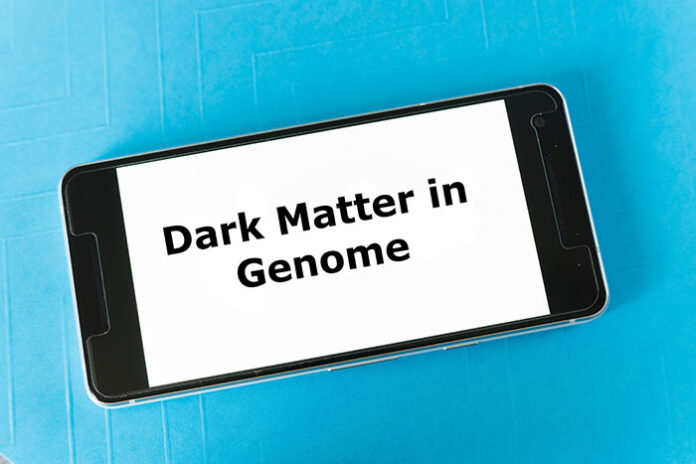ໄດ້ ມະນຸດ ກຳ ມະພັນ Project revealed that ~1-2% of our genome makes functional proteins while the role of the remaining 98-99% remains enigmatic. Researchers have tried to uncover the mysteries surrounding the same and this article throws light on our understanding of its role and implications for ມະນຸດ ສຸຂະພາບ ແລະພະຍາດຕ່າງໆ.
From the time the ມະນຸດ ກຳ ມະພັນ Project (HGP) was completed in April 20031, it was thought that by knowing the entire sequence of ມະນຸດ genome which consists of 3 billion base pairs or ‘pair of letters’, genome will be an open book using which researchers would be able to pin point exactly how a complex organism as a ມະນຸດ being works which will eventually lead to finding our predispositions to various kinds of diseases, enhance our understanding of why disease occurs and finding cure for them as well. However, the situation became very perplexed when the scientists were only able to decipher only a part of it (only ~1-2%) which makes functional proteins that decide our phenotypic existence. The role of 1-2% of the DNA to make functional proteins follows the central dogma of molecular biology which states that DNA is first copied to make RNA, especially mRNA by a process called transcription followed by production of protein by mRNA by translation. In the language of the molecular biologist, this 1-2% of the ມະນຸດ genome codes for functional proteins. The remaining 98-99% is referred to as ‘junk DNA’ or ‘dark ເລື່ອງ’ which does not produce any of the functional proteins mentioned above and is carried as a ‘baggage’ every time a ມະນຸດ being is born. In order to understand the role of the remaining 98-99% of the genome, ENCODE ( ENCyclopedia Of DNA Elements) project2 was launched in September 2003 by the National ມະນຸດ ກຳ ມະພັນ Research Institute (NHGRI).
The ENCODE project findings have revealed that majority of the dark ເລື່ອງ’’ comprises of noncoding DNA sequences that function as essential regulatory elements by turning genes on and off in different type of cells and at different points in time. The spatial and temporal actions of these regulatory sequences is still not completely clear, as some of these (regulatory elements) are located very far away from the gene they act upon while in other cases they may be close together.
The composition of some of the regions of ມະນຸດ genome was known even before the launch of the ມະນຸດ ກຳ ມະພັນ Project in that ~8% of the ມະນຸດ genome is derived from viral genomes embedded in our DNA as ມະນຸດ endogenous retroviruses (HERVs)3. These HERVs have been implicated in providing innate immunity to ມະນຸດ by acting as regulatory elements for genes that control immune function. The functional significance of the this 8% was corroborated by the findings of the ENCODE project which suggested that majority of the ‘dark ເລື່ອງ functions as regulatory elements.
In addition to the ENCODE project findings, a vast amount of research data is available from the past two decades suggesting a plausible regulatory and developmental role for the ‘dark ເລື່ອງ’. Using ກຳ ມະພັນ-wide association studies (GWAS), it has been identified that majority of the noncoding regions of DNA are associated with common diseases and traits4 ແລະຄວາມປ່ຽນແປງໃນພາກພື້ນເຫຼົ່ານີ້ເຮັດຫນ້າທີ່ຄວບຄຸມການເລີ່ມຕົ້ນແລະຄວາມຮຸນແຮງຂອງພະຍາດສະລັບສັບຊ້ອນຈໍານວນຫລາຍເຊັ່ນ: ມະເຮັງ, ພະຍາດຫົວໃຈ, ຄວາມຜິດປົກກະຕິຂອງສະຫມອງ, ໂລກອ້ວນ, ແລະອື່ນໆຈໍານວນຫຼາຍ.5,6. ການສຶກສາຂອງ GWAS ຍັງໄດ້ເປີດເຜີຍວ່າສ່ວນໃຫຍ່ຂອງລໍາດັບ DNA ທີ່ບໍ່ແມ່ນລະຫັດເຫຼົ່ານີ້ຢູ່ໃນ genome ໄດ້ຮັບການຖ່າຍທອດ (ປ່ຽນເປັນ RNA ຈາກ DNA ແຕ່ບໍ່ໄດ້ແປ) ເຂົ້າໄປໃນ RNAs ທີ່ບໍ່ແມ່ນລະຫັດແລະການລົບກວນຂອງກົດລະບຽບຂອງພວກເຂົານໍາໄປສູ່ພະຍາດທີ່ແຕກຕ່າງກັນເຊິ່ງກໍ່ໃຫ້ເກີດຜົນກະທົບ.7. ນີ້ຊີ້ໃຫ້ເຫັນຄວາມສາມາດຂອງ RNAs ທີ່ບໍ່ແມ່ນລະຫັດເພື່ອມີບົດບາດເປັນລະບຽບໃນການພັດທະນາຂອງພະຍາດ8.
ນອກຈາກນັ້ນ, ບາງສິ່ງທີ່ຊ້ໍາກັນຍັງຄົງເປັນ DNA ທີ່ບໍ່ແມ່ນລະຫັດແລະເຮັດຫນ້າທີ່ເປັນລະບຽບເປັນຕົວປັບປຸງ. ດັ່ງທີ່ຄໍາແນະນໍາ, ຕົວເສີມເຫຼົ່ານີ້ເຮັດວຽກໂດຍການເພີ່ມ (ການເພີ່ມ) ການສະແດງອອກຂອງທາດໂປຼຕີນບາງຢ່າງໃນເຊນ. ນີ້ໄດ້ຖືກສະແດງໃຫ້ເຫັນໃນການສຶກສາທີ່ຜ່ານມາ, ບ່ອນທີ່ຜົນກະທົບການປັບປຸງຂອງພາກພື້ນທີ່ບໍ່ແມ່ນລະຫັດຂອງ DNA ເຮັດໃຫ້ຄົນເຈັບມີຄວາມອ່ອນໄຫວຕໍ່ກັບພະຍາດ autoimmune ສະລັບສັບຊ້ອນແລະອາການແພ້ເຊັ່ນ: ພະຍາດລໍາໄສ້ອັກເສບ.9,10, ດັ່ງນັ້ນຈຶ່ງນໍາໄປສູ່ການກໍານົດເປົ້າຫມາຍການປິ່ນປົວທີ່ມີທ່າແຮງໃຫມ່ສໍາລັບການປິ່ນປົວພະຍາດອັກເສບ. ການປັບປຸງໃນ 'ເລື່ອງຊ້ໍາ' ຍັງກ່ຽວຂ້ອງກັບການພັດທະນາສະຫມອງທີ່ການສຶກສາກ່ຽວກັບຫນູໄດ້ສະແດງໃຫ້ເຫັນວ່າການລົບຂອງພາກພື້ນເຫຼົ່ານີ້ນໍາໄປສູ່ຄວາມຜິດປົກກະຕິໃນການພັດທະນາສະຫມອງ.11,12. ການສຶກສາເຫຼົ່ານີ້ອາດຈະຊ່ວຍໃຫ້ພວກເຮົາເຂົ້າໃຈໄດ້ດີຂຶ້ນກ່ຽວກັບພະຍາດທາງ neurological ສະລັບສັບຊ້ອນເຊັ່ນ: Alzheimer's ແລະ Parkinson's. 'ເລື່ອງມືດ' ຍັງໄດ້ຖືກສະແດງໃຫ້ເຫັນວ່າມີບົດບາດໃນການພັດທະນາຂອງມະເຮັງໃນເລືອດ13 ເຊັ່ນ leukemia myelocytic ຊໍາເຮື້ອ (CML) ແລະ leukemia lymphocytic ຊໍາເຮື້ອ (CLL).
Thus, ‘dark matter’ represents an important part of the ມະນຸດ genome than previously realised and has directly influences ມະນຸດ ສຸຂະພາບ by playing a regulatory role in the development and onset of ມະນຸດ diseases as described above.
Does that mean that the entire ‘dark matter’ is either transcribed into non-coding RNAs or play an enhancer role as non-coding DNA by acting as regulatory elements associated with predisposition, onset and variations in the various diseases inflicting ມະນຸດ? The studies performed till now show a strong preponderance for the same and more research in the coming years will help us exactly delineate the function of the entire ‘dark matter’, that will lead to identification of novel targets in the hope of finding cure to the debilitating diseases that inflict the human race.
***
ເອກະສານ:
1. “Human Genome Project Completion: Frequently Asked Questions”. National Human ກຳ ມະພັນ Research Institute (NHGRI). Available online at https://www.genome.gov/human-genome-project/Completion-FAQ ເຂົ້າໃຊ້ໃນວັນທີ 17 ພຶດສະພາ 2020.
2. Smith D., 2017. ຄວາມລຶກລັບ 98%: ນັກວິທະຍາສາດເບິ່ງການສ່ອງແສງຢູ່ໃນ 'genome ຊ້ໍາ'. ມີໃຫ້ອອນໄລນ໌ຢູ່ https://phys.org/news/2017-02-mysterious-scientists-dark-genome.html ເຂົ້າໃຊ້ໃນວັນທີ 17 ພຶດສະພາ 2020.
3. Soni R., 2020. ມະນຸດ ແລະໄວຣັສ: ປະຫວັດຫຍໍ້ຂອງຄວາມສຳພັນທີ່ຊັບຊ້ອນ ແລະຜົນສະທ້ອນຕໍ່ COVID-19. ວິທະຍາສາດເອີຣົບ ປະກາດໃນວັນທີ 08 ພຶດສະພາ 2020. ມີໃຫ້ອອນໄລນ໌ຢູ່ https://www.scientificeuropean.co.uk/humans-and-viruses-a-brief-history-of-their-complex-relationship-and-implications-for-COVID-19 ເຂົ້າໃຊ້ໃນວັນທີ 18 ພຶດສະພາ 2020.
4. Maurano MT, Humbert R, Rynes E, et al. ທ້ອງຖິ່ນທີ່ເປັນລະບົບຂອງການປ່ຽນແປງທີ່ກ່ຽວຂ້ອງກັບພະຍາດທົ່ວໄປໃນ DNA ກົດລະບຽບ. ວິທະຍາສາດ. 2012 ກັນຍາ 7;337(6099):1190-5. DOI: https://doi.org/10.1126/science.1222794
5. ລາຍການຂອງການສຶກສາສະມາຄົມ Genome-Wide ທີ່ເຜີຍແຜ່. http://www.genome.gov/gwastudies.
6. Hindorff LA, Sethupathy P, et al 2009. ຜົນກະທົບທາງດ້ານ etiologic ທີ່ມີທ່າແຮງ ແລະການເຮັດວຽກຂອງ genome-wide ສະມາຄົມ loci ສໍາລັບພະຍາດ ແລະລັກສະນະຕ່າງໆຂອງມະນຸດ. Proc Natl Acad Sci US A. 2009, 106: 9362-9367. DOI: https://doi.org/10.1073/pnas.0903103106
7. St. Laurent G, Vyatkin Y, ແລະ Kapranov P. Dark matter RNA ສ່ອງແສງປິດສະໜາຂອງການສຶກສາສະມາຄົມທົ່ວ genome. BMC Med 12, 97 (2014). DOI: https://doi.org/10.1186/1741-7015-12-97
8. Martin L, Chang HY. ການເປີດເຜີຍບົດບາດຂອງພັນທຸກໍາຂອງ "ເລື່ອງຊ້ໍາ" ໃນພະຍາດຂອງມະນຸດ. J Clin ລົງທຶນ. ປີ 2012;122 (5): 1589-1595. https://doi.org/10.1172/JCI60020
9. ສະຖາບັນ Babraham 2020. ຄົ້ນພົບວ່າ 'ບັນຫາຄວາມມືດ' ພາກພື້ນຂອງ genome ມີຜົນກະທົບຕໍ່ພະຍາດອັກເສບແນວໃດ. ປະກາດໃນວັນທີ 13 ພຶດສະພາ 2020. ມີຈຳໜ່າຍແລ້ວທີ່ https://www.babraham.ac.uk/news/2020/05/uncovering-how-dark-matter-regions-genome-affect-inflammatory-diseases ເຂົ້າໃຊ້ໃນວັນທີ 14 ພຶດສະພາ 2020.
10. Nasrallah, R., Imianowski, CJ, Bossini-Castillo, L. et al. 2020. A distal enhancer at risk locus 11q13.5 ສົ່ງເສີມການສະກັດກັ້ນ colitis ໂດຍຈຸລັງ Treg. ທຳມະຊາດ (2020). DOI: https://doi.org/10.1038/s41586-020-2296-7
11. Dickel, DE et al. 2018. ການປັບປຸງການອະນຸລັກພິເສດແມ່ນຕ້ອງການສໍາລັບການພັດທະນາປົກກະຕິ. Cell 172, ສະບັບທີ 3, P491-499.E15, ວັນທີ 25 ມັງກອນ 2018. DOI: https://doi.org/10.1016/j.cell.2017.12.017
12. 'Dark matter' DNA ມີອິດທິພົນຕໍ່ການພັດທະນາສະຫມອງ DOI: https://doi.org/10.1038/d41586-018-00920-x
13. ເລື່ອງຄວາມມືດ: ການຈໍາແນກມະເຮັງເມັດເລືອດອ່ອນໆໂດຍໃຊ້ DNA DOI ທີ່ມືດມົນທີ່ສຸດ: https://doi.org/10.1371/journal.pcbi.1007332
***






































